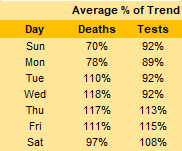Many states do not report results daily. Many states show weekly cycles of under-reporting on certain days and over-reporting on other days. For example, my state (WA) does not report on Sundays. Consequently, I smooth test data and fatality data on the basis of a 7-day cycle.
Smoothing periods shorter than 7 days or longer than 7 days risk disproportionately weighting the days on which results are under-reported or over-reported.
Here are the typical deviations from the trend by weekday at the national level:

As an example of why a 7-day period is needed, suppose smoothing of deaths data was done on a 3-day basis for the period Saturday through Monday. In that case, the 5-day period would be 81.7% of trend, because of typical underreporting on those days. Similarly, if smoothing of deaths was performed for the 3 days of Tuesday through Thursday, that 3-day period would be 115% of trend. The full 7 days needs to be included to obtain an accurate picture of the data for the week.
At the state level, with some states not reporting data at all on certain days, the problem becomes worse.
Periods longer than 7 days have a similar problem: they double-count days that are lower than average or higher than average, and therefore reduce accuracy.
Smoothing periods that are multiples of 7 days do not have this problem, so smoothing periods of 7, 14, and 21 days are all accurate.
